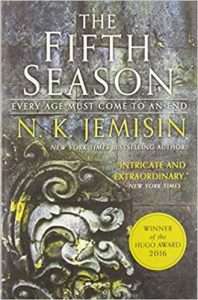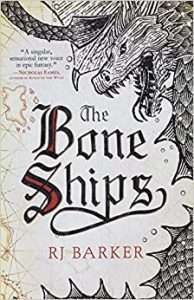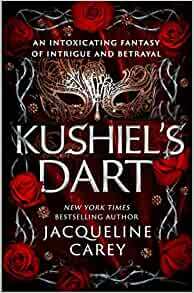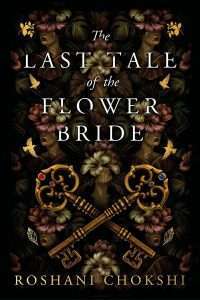Adrian Collins's Blog, page 105
February 25, 2023
Dark Fantasy: Where to Start Reading
If you think it’s difficult getting grimdark fantasy fans to agree on a definition or where to start reading, then you’re going to be blown away by how difficult it is to do the same for dark fantasy. Add a century more of fiction and discussion to try and find out what dark fantasy is and what needs to be on a reading guide for it and you can find yourself in a nightmare pretty quickly. So, we can all argue until we’re blue in the face about the exact definition, who invented it, which of the people who coined the term was correct, and all that jam. Or I can tell you that we’ve built this list based on what we think a new dark fantasy fan in 2023 needs to read to get themselves rolling in this wildly popular sub genre, and just bloody well get on with it.
Once again, the GdM team and I sat down and had a chin wag about how we could create this list and agreed that we would try to give a nod to both those who laid the path, and the newer authors who walk and further develop it.
We give you, in no particular order of preference, and in full knowledge this is going to kick off some really good discussions and arguments, Grimdark Magazine’s where to start reading dark fantasy list.
The Fifth Season by N.K. JemisinThe Fifth Season starts with the end of the world, and things only get worse from there. Brutal, bleak and beautifully written, this is the first book in N.K. Jemisin’s Hugo Award winning The Broken Earth trilogy. A biting examination of societal and structural oppression, The Fifth Season is a must-read for any fantasy fan wishing to explore the darker side of the genre.
About the bookThis is the way the world ends. . .for the last time.
It starts with the great red rift across the heart of the world’s sole continent, spewing ash that blots out the sun. It starts with death, with a murdered son and a missing daughter. It starts with betrayal, and long dormant wounds rising up to fester.
This is the Stillness, a land long familiar with catastrophe, where the power of the earth is wielded as a weapon. And where there is no mercy.
Read the bookThe Justice of Kings by Richard Swan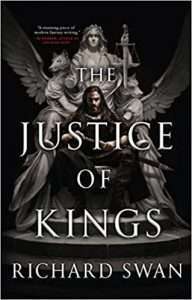 In Richard Swan’s new fantasy trilogy, starting with The Justice of Kings, a rich low magic world is brought to life through brilliant characters and their arcs. A mixture of detective work, dark fantasy, and low fantasy, I’ll be really surprised if this book isn’t on a few best of 2022 lists this year.
In Richard Swan’s new fantasy trilogy, starting with The Justice of Kings, a rich low magic world is brought to life through brilliant characters and their arcs. A mixture of detective work, dark fantasy, and low fantasy, I’ll be really surprised if this book isn’t on a few best of 2022 lists this year.
Read the rest of our review here.
About the bookThe Empire of the Wolf simmers with unrest. Rebels, heretics, and powerful patricians all challenge the power of the Imperial throne.
Only the Order of Justices stands in the way of chaos. Sir Konrad Vonvalt is the most feared Justice of all, upholding the law by way of his sharp mind, arcane powers, and skill as a swordsman. At his side stands Helena Sedanka, his talented protégé, orphaned by the wars that forged the Empire.
When the pair investigates the murder of a provincial aristocrat, they unearth a conspiracy that stretches to the very top of Imperial society. As the stakes rise and become ever more personal, Vonvalt and Helena must make a choice: Will they abandon the laws they’ve sworn to uphold, in order to protect the Empire?
Read the bookThe Bone Ships by R.J. BarkerAs winner of the 2020 British Fantasy award, The Bone Ships charts the course as captain of modern-day seafaring warfare. This first installment of the Tide Child trilogy starts within an endless war, fought with boneships built from ancient dragons. Rumors of dragon sightings spin the nations of the Hundred Isles into turmoil. A new dragon hunt begins. R.J. Baker makes waves with his richly detailed world in The Bone Ships.
About the bookTwo nations at war. One prize beyond compare.
For generations, the Hundred Isles have built their ships from the bones of ancient dragons to fight an endless war. The dragons disappeared, but the battles for supremacy persisted.
Now, the first dragon in centuries has been spotted in far-off waters, and both sides see a chance to shift the balance of power in their favor. Because whoever catches it will win not only glory but the war.
Read the bookDaughter of the Empire by Janny Wurts and Raymond E. Feist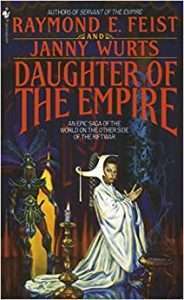 Daughter of the Empire, and by extension The Empire Trilogy, is the brainchild of two of fantasy’s living legends, Raymond E. Feist, and Janny Wurts. It is a high fantasy with a dark edge, political machinations, and the heroic struggles of Mara. Often topping many “best of” lists since its first publishing in 1987, it has become a foundational fantasy for many of today’s dark fantasy readers.
Daughter of the Empire, and by extension The Empire Trilogy, is the brainchild of two of fantasy’s living legends, Raymond E. Feist, and Janny Wurts. It is a high fantasy with a dark edge, political machinations, and the heroic struggles of Mara. Often topping many “best of” lists since its first publishing in 1987, it has become a foundational fantasy for many of today’s dark fantasy readers.
Magic and murder engulf the realm of Kelewan. Fierce warlords ignite a bitter blood feud to enslave the empire of Tsuranuanni. While in the opulent Imperial courts, assassins and spy-master plot cunning and devious intrigues against the rightful heir. Now Mara, a young, untested Ruling lady, is called upon to lead her people in a heroic struggle for survival. But first she must rally an army of rebel warriors, form a pact with the alien cho-ja, and marry the son of a hated enemy. Only then can Mara face her most dangerous foe of all—in his own impregnable stronghold.
Read the bookKushiel’s Dark by Jacqueline CareyJacqueline Carey’s Kushiel’s Dart series is genre defining in many ways – and a book that is as timely now as it was when it was first published. Set in a world inspired by the Renaissance, the story centres around Phèdre, a courtesan who experiences pain and pleasure as one. But she is as clever as she is skilled, and soon finds herself in the midst of a conspiracy that threatens her homeland. Carey masterfully writes a nuanced protagonist, a brilliant villainess to fall for and a story to be utterly seduced by – all the while making a stand for free love and reproductive rights. As the motto of Terre d’Ange says: Love as thou wilt.
About the bookThe first book in the Kushiel’s Legacy series is a novel of grandeur, luxuriance, sacrifice, betrayal, and deeply laid conspiracies. A world of cunning poets, deadly courtiers, deposed rulers and a besieged Queen, a warrior-priest, the Prince of Travelers, barbarian warlords, heroic traitors, and a truly Machiavellian villainess…all seen through the unflinching eyes of an unforgettable heroine.
A nation born of angels, vast and intricate and surrounded by danger… a woman born to servitude, unknowingly given access to the secrets of the realm…
Born with a scarlet mote in her left eye, Phédre nó Delaunay is sold into indentured servitude as a child. When her bond is purchased by an enigmatic nobleman, she is trained in history, theology, politics, foreign languages, the arts of pleasure. And above all, the ability to observe, remember, and analyze. Exquisite courtesan, talented spy…and unlikely heroine. But when Phédre stumbles upon a plot that threatens her homeland, Terre d’Ange, she has no choice.
Betrayed into captivity in the barbarous northland of Skaldia and accompanied only by a disdainful young warrior-priest, Phédre makes a harrowing escape and an even more harrowing journey to return to her people and deliver a warning of the impending invasion. And that proves only the first step in a quest that will take her to the edge of despair and beyond.
Phédre nó Delaunay is the woman who holds the keys to her realm’s deadly secrets, and whose courage will decide the very future of her world.
Read the bookAmerican Gods by Neil Gaiman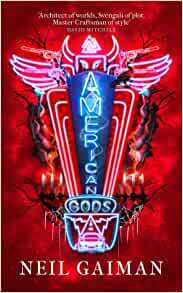 Ancient mythology collides with the deities of modern culture in American Gods, Neil Gaiman’s Hugo- and Nebula-award winning dark fantasy classic. First published in 2001, American Gods was later adapted into a three-season TV series by Starz. The novel centers on ex-convict Shadow, who is caught in an epic battle between the Old Gods of classic mythology and the New Gods of modern technology, pop culture, and conspiracy theories. American Gods is a sinister treat from one of the all-time masters of dark fantasy.
Ancient mythology collides with the deities of modern culture in American Gods, Neil Gaiman’s Hugo- and Nebula-award winning dark fantasy classic. First published in 2001, American Gods was later adapted into a three-season TV series by Starz. The novel centers on ex-convict Shadow, who is caught in an epic battle between the Old Gods of classic mythology and the New Gods of modern technology, pop culture, and conspiracy theories. American Gods is a sinister treat from one of the all-time masters of dark fantasy.
Released from prison, Shadow finds his world turned upside down. His wife has been killed; a stranger offers him a job and Shadow, with nothing to lose, accepts. But a storm is coming. Beneath the placid surface of everyday life, a war is being fought – and the prize is the very soul of America.
An inspired combination of mythology, adventure, and illusion, American Gods is a dark and kaleidoscopic journey deep into myth and across an America at once eerily familiar and utterly alien. It is, quite simply, a contemporary masterpiece.
Read the bookThe Gunslinger by Stephen King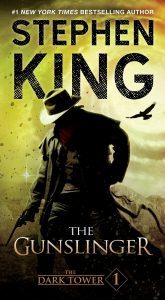 All told, it was a joy to revisit The Gunslinger, which is, to me at least, one of the key progenitors of the modern grimdark genre.
All told, it was a joy to revisit The Gunslinger, which is, to me at least, one of the key progenitors of the modern grimdark genre.
Read our full review here.
About the bookIn the first book of this series, Stephen King introduces readers to one of his most enigmatic heroes, Roland of Gilead, The Last Gunslinger.
He is a haunting figure, a loner on a spellbinding journey into good and evil. In his desolate world, which frighteningly mirrors our own, Roland pursues The Man in Black, encounters an alluring woman named Alice, and begins a friendship with the Kid from Earth called Jake. Both grippingly realistic and eerily dreamlike, The Gunslinger leaves readers eagerly awaiting the next chapter.
Read the bookThe Deathless by Peter Newman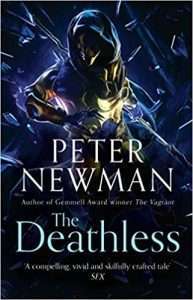 Newman’s first entry into a new fantasy series presents a world with floating castles that are connected by roads of crystal alongside which human settlements are erected. These Godsroads are safe passages between the floating fortresses of the great houses. Covering most of the created environment is The Wilds – a macabre and terrifying forested area full of unspeakable horrors, extreme darkness, shifting trees, and creatures such as the infamous Scurrying Corpseman and Whispercages. Certain segments of the narrative that were set in The Wilds were truly intense and felt like a nightmare right out of a Brothers Grimm fairy tale.
Newman’s first entry into a new fantasy series presents a world with floating castles that are connected by roads of crystal alongside which human settlements are erected. These Godsroads are safe passages between the floating fortresses of the great houses. Covering most of the created environment is The Wilds – a macabre and terrifying forested area full of unspeakable horrors, extreme darkness, shifting trees, and creatures such as the infamous Scurrying Corpseman and Whispercages. Certain segments of the narrative that were set in The Wilds were truly intense and felt like a nightmare right out of a Brothers Grimm fairy tale.
Read the rest of James’ review on Fantasy Book Review.
About the bookThe demons…
In the endless forests of the Wild, humanity scratches a living by the side of the great Godroads, paths of crystal that provide safe passage and hold back the infernal tide. Creatures lurk within the trees, watching, and plucking those who stray too far from safety.
The Deathless…
In crystal castles held aloft on magical currents, seven timeless royal families reign, protecting humanity from the spread of the Wild and its demons. Born and reborn into flawless bodies, the Deathless are as immortal as the precious stones from which they take their names. For generations a fragile balance has held.
And the damned…
House Sapphire, one of the ancient Deathless families, is riven by suspicion and madness. Whole villages are disappearing as the hunting expeditions holding the Wild at bay begin to fail.
Then, when assassins strike, House Sapphire shatters.
Nothing lasts forever.
Read the bookLast Tale of the Flower Bride by Roshani ChokskiChokshi has a magical way with words, able to turn a simple sentence into something that draws you into her world and doesn’t let you escape again. And this writing is really where The Last Tale of the Flower Bride excels. A mythical, haunting story told in lyrical prose that almost manages to hide how dark it truly is.
Read our review of Last Tale of the Flower Bride.
About the bookOnce upon a time, a man who believed in fairy tales married a beautiful, mysterious woman named Indigo Maxwell-Casteñada. He was a scholar of myths. She was heiress to a fortune. They exchanged gifts and stories and believed they would live happily ever after – and in exchange for her love, Indigo extracted a promise: that her bridegroom would never pry into her past.
But when Indigo learns that her estranged aunt is dying and the couple is forced to return to her childhood home, the House of Dreams, the bridegroom soon finds himself unable to resist. For within the crumbling manor’s extravagant rooms and musty halls, there lurks the shadow of another girl: Azure, Indigo’s dearest childhood friend, who disappeared without a trace.
As the house slowly reveals his wife’s secrets, the bridegroom will be forced to choose between reality and fantasy, even if doing so threatens to destroy their marriage . . . or their lives.
Read the bookThe Dragonbone Chair by Tad Williams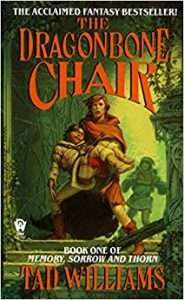 The first novel in Memory, Sorrow and Thorn, one of the greatest epic fantasy series of the modern era, The Dragonbone Chair placed Tad Williams at the pinnacle of the genre when it was released in 1988. Its a slow-burn tale set in a rich and detailed world under threat from dark sorcery and banished terrors. An acknowledged influence on A Song of Ice and Fire, The Dragonbone Chair is an essential read.
The first novel in Memory, Sorrow and Thorn, one of the greatest epic fantasy series of the modern era, The Dragonbone Chair placed Tad Williams at the pinnacle of the genre when it was released in 1988. Its a slow-burn tale set in a rich and detailed world under threat from dark sorcery and banished terrors. An acknowledged influence on A Song of Ice and Fire, The Dragonbone Chair is an essential read.
Read our series review here.
About the bookA war fueled by the powers of dark sorcery is about to engulf the peaceful land of Osten Ard—for Prester John, the High King, lies dying. And with his death, the Storm King, the undead ruler of the elf-like Sithi, seizes the chance to regain his lost realm through a pact with the newly ascended king. Knowing the consequences of this bargain, the king’s younger brother joins with a small, scattered group of scholars, the League of the Scroll, to confront the true danger threatening Osten Ard.
Simon, a kitchen boy from the royal castle unknowingly apprenticed to a member of this League, will be sent on a quest that offers the only hope of salvation, a deadly riddle concerning long-lost swords of power. Compelled by fate and perilous magics, he must leave the only home he’s ever known and face enemies more terrifying than Osten Ard has ever seen, even as the land itself begins to die.
After the landmark Memory, Sorrow, and Thorn trilogy, the epic saga of Osten Ard continues with The Heart of What Was Lost. Then don’t miss the sequel trilogy, The Last King of Osten Ard, beginning with The Witchwood Crown!
Read the book
The post Dark Fantasy: Where to Start Reading appeared first on Grimdark Magazine.
REVIEW: Son of the Poison Rose by Jonathan Maberry
Son of the Poison Rose is the second instalment of Maberry’s epic dark fantasy series Kagen the Damned. However, Maberry is a prolific writer, with accolades such as numerous Bram Stoker Awards and being a New York Times bestselling author. If the Kagen series leaves you wanting more, picking up some of Maberry’s back catalogue may scratch the itch while we wait for the next book in this series. In particular, his horror and science fiction works will probably appeal if you have enjoyed these fantasy novels. There is also a Kagen novella called I Say Your Name in the Dark Nights, which is available as an eBook.
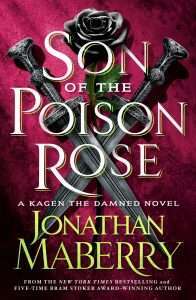 Son of the Poison Rose picks up almost immediately as the first novel, Kagen the Damned, finishes. That is essential reading; this is not a series where you can pick and choose where to start. The world-building and knowledge of the first book are vital as Maberry continues to have a fast-paced narrative. This meant that the novel itself felt like a much quicker read than one could have expected, given its size. I made swift progress but did not feel like the plot was rushed. The narrative again follows multiple perspectives, the majority being Kagen, but others are familiar from the first book and new to this one. Sometimes the chapter perspectives run concurrently, especially with critical parts of the novel, which helps to emphasise the importance of that particular event. The chapters vary between short and very short, but Maberry’s writing is immersive and entertaining, so this did not feel pithy or clunky.
Son of the Poison Rose picks up almost immediately as the first novel, Kagen the Damned, finishes. That is essential reading; this is not a series where you can pick and choose where to start. The world-building and knowledge of the first book are vital as Maberry continues to have a fast-paced narrative. This meant that the novel itself felt like a much quicker read than one could have expected, given its size. I made swift progress but did not feel like the plot was rushed. The narrative again follows multiple perspectives, the majority being Kagen, but others are familiar from the first book and new to this one. Sometimes the chapter perspectives run concurrently, especially with critical parts of the novel, which helps to emphasise the importance of that particular event. The chapters vary between short and very short, but Maberry’s writing is immersive and entertaining, so this did not feel pithy or clunky.
Although the pacing began very similarly to the first novel, Son of the Poison Rose, it is not quite as action-packed from the get-go right up to the finale. There are peaks and troughs of action here, with skirmishes and smaller-scale battles teamed with covert movements from place to place, which matches the political situation at this point in the series. The invasion is over, and now it is more about maintaining control or forming a rebellion, depending upon which side you fall. However, this gives Maberry’s characters a chance to develop and for us as a reader to strengthen our bond with them. The camaraderie between Kagen, Tuke, and Filia is shown more as they travel through the empire. We see more of the politicking of Mother Frey, and even characters who, after the last book, I could have sworn were irredeemable, have moments that earn them flashes of sympathy.
This is still a dark and gritty novel. In particular, I found the chapters of the Witch King’s “children” harrowing to read. The battle scenes are well-written and engaging on both small and large scales. The final battle, in particular stands out to me as one of my favourite parts of Son of the Poison Rose. There are a lot of fantastical references in this series that readers will enjoy, for example, Maberry’s use of Lovecraftian tradition and the range of magical monsters that are either referred to or appear in Son of the Poison Rose. I would have loved to have spent more time with the Unbladed or seen more marauding across the empire with the Bloody Bastards, but I am hoping this will happen in the next novel or be explored more in other short fiction.
Maberry ties up some loose ends, but Son of the Poison Rose does end on a cliffhanger, so I hope the next novel in the series will pick up where this one has left off. Many avenues are left to explore, so I am excited about whatever Maberry writes next. Son of the Poison Rose is a worthwhile investment in your reading time. If you loved Kagen the Damned you would enjoy this. If you like dark epic fantasy with magic, scheming, and a fair chunk of violence, then this series is one to pick up. Thank you very much to Jonathan Maberry and the St. Martin’s Press team for sending me a copy of Son of the Poison Rose so I could review it for Grimdark Magazine.
4.5/5
Read Son of the Poison Rose by Jonathan MaberryThe post REVIEW: Son of the Poison Rose by Jonathan Maberry appeared first on Grimdark Magazine.
February 24, 2023
REVIEW: Miskatonic by Mark Sable
Miskatonic by Mark Sable is an indie comic book I stumbled upon by accident. Lovecraft has a somewhat sketchy history with adaptations of his work to comic books with Alan Moore’s Providence and a few others that had issues to say the least. However, there was something about the cover that lured me in. They say you can’t judge a book by its cover but that is frequently the deciding factor in a purchase, and I was immediately drawn in by the fantastic depiction of agent Miranda Keller on the front.
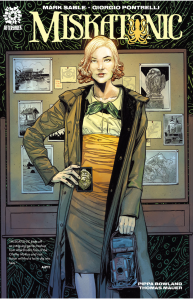 The premise is Miranda Keller is one of the few remaining female agents in the Bureau of Investigation when J. Edgar Hoover takes over. In real life, J. Edgar Hoover inherited two female agents as well as promoted one to agent status. He also fired those two female agents and the one he promoted eventually quit. The notoriously racist and sexist director serves as an interesting foil for the opening of the story. Miranda knows that Hoover doesn’t want her, and she has no future in her chosen profession but he’s willing to give her one last case as a going away present: investigate the murder of a upper class citizen in Miskatonic Valley, Massachusetts.
The premise is Miranda Keller is one of the few remaining female agents in the Bureau of Investigation when J. Edgar Hoover takes over. In real life, J. Edgar Hoover inherited two female agents as well as promoted one to agent status. He also fired those two female agents and the one he promoted eventually quit. The notoriously racist and sexist director serves as an interesting foil for the opening of the story. Miranda knows that Hoover doesn’t want her, and she has no future in her chosen profession but he’s willing to give her one last case as a going away present: investigate the murder of a upper class citizen in Miskatonic Valley, Massachusetts.
Miranda joins up with Detective Malone from The Horror of Red Hook, who is a traumatized and racist protagonist who continuously warns our heroine of messing with forces that mankind does not understand. He’s an interesting character because while an ally of Miranda and well- intentioned, his beliefs are so repellant to both our heroine as well as the reader that he is as much an obstacle as a help. Unfortunately, there are many places in 1920s America where a white male is necessary to get any traction whatsoever.
What follows is basically a sort of comic book version of Forrest Gump crossed with the Cthulhu Mythos. Miranda’s investigation basically takes her through a large portion of H.P. Lovecraft’s stories as they’re happening with The Shadow over Innsmouth, The Dunwich Horror, The Thing on the Doorstep, Herbert West: Reanimator, and a few other tales. Miranda is initially hesitant to accept the reality of the supernatural but increasingly finds herself pressing forward, even in the face of the Mythos, just because she refuses to be intimidated into quitting.
Miranda is a fantastic protagonist and I absolutely love her hardnosed edge as well as determination as well as love of justice. Miranda keeps most of her feelings bottled up that she remains a mystery throughout circumstances that would have forced most Lovecraft protagonists into a quivering wreck. While this is a low bar to clear, she’s also a comic book heroine mercifully free of cheesecake. Miranda is also at least partially queer, responding well to Asenath Waite’s advances but perhaps not as deeply as her homophobic partner suspects.
Miskatonic is a comic that benefits from familiarity with HP Lovecraft’s stories but works well even if you don’t know the original material. Indeed, I think the author may have slightly overdone the references, but I enjoyed the story a great deal anyway. I especially liked the inclusion of Azenath Waite, who becomes a femme fatale who attempts (semi-successfully) to seduce Miranda over to her side.
The art of Miskatonic is fantastic and the writing is great. I find it a shame that this comic was a standalone with only one short sequel in Miskatonic: Death May Day. I would have gladly read an ongoing starring these characters. Malone is a terrible person, but he’s interestingly flawed and plays well against Miranda. So, if you want a nice PG-13 comic that interacts well with Lovecraft’s mythos as well as addresses the racism but is not dominated by it, then this is the comic for you.
Read Miskatonic by Mark SableThe post REVIEW: Miskatonic by Mark Sable appeared first on Grimdark Magazine.
Titan announces new Dead by Daylight series
More and more lately it seems like Titan is positioning themselves to absolutely corner the market on licensed comic book adaptations. They’ve done stellar work in the last couple years with movies, TV, and novels and now they’re leaping into the realm of video game adaptations with the survival horror hit Dead By Daylight. Capitalizing on the unique perspective pitting players against each other as both killer and survivors, the game emulates the hair-raising thrills of some of the horror genre’s most spine-tingling and beloved moments and tropes.

Unlettered interior art for Dead by Dawn
With the comic book version of Dead By Daylight, Titan has assembled a powerhouse team of heavy-hitters (Nadia Shammas [W], Dillon Snook [A], Emilio Lecce [C]) to portray a prequel story that establishes the origins of many themes and organizations that fans of the game itself will find familiar and newcomers engrossing. It’ll be exciting to see a fresh, original take on an already established setting provided by star writer Nadia Shammas, with art duties tackled by Dillon Snook and Emilio Lecce. The art itself in the upcoming comic is a departure from the gritty, realistic graphics of Dead By Daylight the game but instead of being a jarring difference it’s very cool. Fresh and frenetic, lending to the to the more sinister and surreal aspects of the game’s world. Dead By Daylight’s art is bright and stylized, creating a shocking tableau when blood is splattered across the page.
Set for release this spring, Dead By Daylight promises to be something fans of horror should keep on their radars and add to their pull lists. Whether you’re a fan of the game or just looking for something new and frightening to sink your teeth into, you’ll be sure to get a kick out of the upcoming book. Titan scores major bonus points for the first issue’s release, as they’ve enlisted a whole trove of amazing artists to contribute variant covers for Dead By Daylight’s debut issue including Lenka Simeckova, Ivan Tao, and Chris Shehan—but for my money all they had to do to guarantee me snagging the first issue was the glorious Jae Lee cover. Wait till you get a load of that one. So, comic fans and horror hounds, save the date. May 24th Dead By Daylight will be darkening the stands of your local comic shops, and you definitely don’t want to miss out.
Pre-order Dead by DaylightThe post Titan announces new Dead by Daylight series appeared first on Grimdark Magazine.
February 23, 2023
REVIEW: The Salt Grows Heavy by Cassandra Khaw
Cassandra Khaw’s new novella, The Salt Grows Heavy, is a darkly beautiful nightmare brought to life, which will drive a dagger through your heart and leave you begging for more.
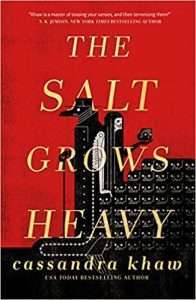 The Salt Grows Heavy is narrated by a mermaid who, as in The Little Mermaid, has become mute for her royal human partner. But in Khaw’s tale, the mermaid loses her tongue in a bizarreritual of autosarcophagy that promotes spousal fealty and obedience. As the novel opens, the couple’s ravenous daughters have recently devoured their father and the people of his kingdom, reducing the remnants to ash.
The Salt Grows Heavy is narrated by a mermaid who, as in The Little Mermaid, has become mute for her royal human partner. But in Khaw’s tale, the mermaid loses her tongue in a bizarreritual of autosarcophagy that promotes spousal fealty and obedience. As the novel opens, the couple’s ravenous daughters have recently devoured their father and the people of his kingdom, reducing the remnants to ash.
In the wake of this cannibalistic apocalypse, the narrator and her companion, an androgynous plague doctor with a raptor-like face, venture to a strange village. The children there appear to be part of a cult controlled by three self-described saints who practice the most macabre forms of surgery in their pursuit of an unspeakable end.
The Salt Grows Heavy is equally grotesque and enchanting. Cassandra Khaw’s writing is immaculate, with every word carefully chosen for maximum impact. The lyricism of her prose is juxtaposed with the horrifying imagery of the story, which includes detailed scenes of bodily mutilation and consumption of human flesh.
For all its horror, The Salt Grows Heavy is also a touchingly restrained love story. A fitting subtitle for Khaw’s novella could be, “Love in the Time of Cannibalism.” Like the classic Love in the Time of Cholera written by the Nobel Prize-winning master of magical realism, Gabriel García Márquez, The Salt Grows Heavy is ultimately a story about the enduring power of love. But in Cassandra Khaw’s case, this love story is set against the darkest of dark fantasy.
The Salt Grows Heavy feels like a hallucinatory night terror from Hans Christian Andersen. Anderson’s original The Little Mermaid is, of course, much darker than the version popularized by Disney. But Khaw cranks the darkness knob all the way to the “black hole” setting, sucking the reader into the story and refusing to let go.
Unable to extricate myself from Cassandra Khaw’s grasp at the end of the novella, I immediately flipped back to the beginning to prolong my immersive experience in her dark world. The lyricism and inventiveness of Khaw’s prose struck me even more on the second read, as many small details emerged that I had overlooked during my first time through. Ultimately, I forced myself to put the book down, so I could write this review and share the grim beauty of The Salt Grows Heavy with all of you.
The Salt Grows Heavy is a truly mesmerizing story and one of the finest works of horror and dark fantasy I have ever read, dripping with a gruesome and disquieting passion.
5/5
Read The Salt Grows Heavy by Cassandra KhawThe post REVIEW: The Salt Grows Heavy by Cassandra Khaw appeared first on Grimdark Magazine.
February 21, 2023
REVIEW: The Last Stand of Mary Good Crow by Rachel Aaron
The Last Stand of Mary Good Crow is a fantasy Western by Rachel Aaron (Minimum Wage Magic). As anyone who knows me can attest, I am a huge fan of Weird Westerns. In addition to writing my own, I’m a huge fan of R.S. Belcher’s Golgotha series and the indie Bulletproof Witch series by Francis James Blair. Honestly, after finishing it, I think it is better than all of those books.
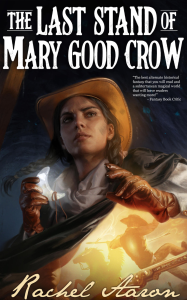 The premise is it is an alternate history version of Earth during the Wild West expansion. Rather than gold, the most valuable substance is the mysterious “crystal” that possesses many mystical properties that amount to allowing magic to be used. It is, understandably, sought by many- many prospectors. The town of Medicine Rocks, which is a name none of the settlers understand, is full of fortune hunters willing to do anything to get more of it. Despite the name, the book is actually about three separate women who share the narrative.
The premise is it is an alternate history version of Earth during the Wild West expansion. Rather than gold, the most valuable substance is the mysterious “crystal” that possesses many mystical properties that amount to allowing magic to be used. It is, understandably, sought by many- many prospectors. The town of Medicine Rocks, which is a name none of the settlers understand, is full of fortune hunters willing to do anything to get more of it. Despite the name, the book is actually about three separate women who share the narrative.
The first is the titular Mary Good Crow, a young half-Lakota woman raised by Catholic Nuns and subject to all the racism you would suspect. Mary is capable of “hearing” crystal and serves as a guide through the labyrinthine mines beneath Medicine Rocks. This despite the fact the prospectors are as inclined to cheat or assault her as pay her for her time. Mary is a really nice young woman but a bit too demure and polite, which may be a literal survival mechanism in her case. Those expecting a spitfire with her will be sadly disappointed but the other two more than make up for that.
In addition to Mary, there’s also Josie the (seeming) rich girl from back East who is coming to revive her uncle’s failing mining business. She wants to become a rich mining baroness and achieve independence but has found the majority of her inheritance has already been stolen by the crooked forces inhabiting this town. Finally, there’s Ren, who has allied herself with those corrupt forces but is Josie’s only friend. Ren would do anything to find out who killed her family and that includes betray a childhood companion who wants to go into business with her. She’s also got haunted crystal pistols containing the ghost of her insane evil wizard father. That’s a thing, apparently, yeah.
It is not a romanticized view of the West since much is made of the US cavalry’s terrifying effect on Mary Good Crow as well as the fact they fully endorse Custer’s cowardly attempt to take the Sioux nation’s women and children hostage. That particular event is happening simultaneously with the book and threatens to upend the plot about locating a mother load of crystal. Some people will love the tie-in to actual history while others may feel it’s in poor taste. I am more of the former than the latter.
Oddly, in addition to the Wild West, the book strongly reminds me of Final Fantasy VII. The harvesting of the crystal is analogous to harvesting mako. Humans and their greed want to rip it from the Earth no matter the cost with devastating consequences. However, it is so useful and powerful that you understand why they’re doing it. Certainly, it’s the only thing that might help the Sioux stop the genocide of their people. Nevertheless, the book gives a kind of environmentally friendly aesop of, “Don’t take the Lifestream crystals from the Earth.”
I very much enjoyed the twists and turns throughout this book and strongly recommend it. No one’s allegiances are entirely set and the only genuinely good person in the story is Mary Good Crow. Even she has a dark side that she struggles to keep suppressed as a matter of sheer survival. I think fans of the Weird West and urban fantasy both will enjoy this novel.
Read The Last Stand of Mary Good Crow by Rachel AaronThe post REVIEW: The Last Stand of Mary Good Crow by Rachel Aaron appeared first on Grimdark Magazine.
Grimdark Magazine’s statement on AI technologies
Clarkesworld has paused submissions while they figure out what to do about the deluge of AI submissions they are receiving. With that in mind, we are overdue releasing our position on AI work and AI assisted work, and discussing the impact on 2023 (and ongoing’s) open window.
AI artworkGrimdark Magazine will not knowingly use AI artworks for our covers or advertising. We will continue to pay human artists and designers to create artwork for humans. Our agreements will be updated to reflect this position.
Some AI art looks cool as all hell, but for me, art is human expression created by human hands. I love handing what money we have to people like those I sat with in art class drawing space marines and knights for all those years in school, and designers like my mother who used to turn muscle car photographs into magazine covers on a light box before moving to Corel Draw, Photoshop, and InDesign.
That matters to me, and it matters to the team, and will remain our stance, ongoing.
AI fiction and non-fictionGrimdark Magazine will not knowingly accept and publish AI generated or assisted short fiction or articles. Our agreements will be updated to reflect this position.
In addition, Beth and I (and the other team members we’d need to loop in to do an open window) do not have the resources to sift through the levels of AI generated submissions we believe an open window will receive. As Neil said, many of those stories are relatively easy to spot, but at the rate AI learns, we can expect it to keep just getting harder to detect at a rapid rate.
We still volunteer our time to put together this magazine, and it takes a lot of hours to create a quarterly issue or anthology. I just don’t see the upside to burning out the team on this problem until there is a reliable tech solution that is affordable for our operating budget.
Therefore, Grimdark Magazine is is pausing future open window plans for 2023 and will continue on a solicitation-only basis until we have an efficient solution.
Recognising the impactOne of the reasons I started GdM was to provide a market for people who wrote grimdark fiction–both established and newer authors. Those authors might be from less well recognised areas of the world like APAC (where I’m from) or Eastern Europe or LATAM, who struggle to breach western markets. They might be marginalised people looking to get their voice out there. They might be somebody’s mum who only ever gets to be on a cover once and this is it. They might be the next big thing looking for a credit to put on their pitch letter.
To those people, I am sorry.
I get it. It’s a shit situation. I don’t write this with a solution in mind. I don’t have one, yet. I’ll be keeping an eye on the market and dig into it when we can so we can run a very overdue open window without sinking huge amounts of our time into AI generated rubbish.
Stick with us. This is a big topic in our tiny corner of the industry. I’ll keep putting out updates as I have them, as I would love to find a way to run a submissions window this year.
The post Grimdark Magazine’s statement on AI technologies appeared first on Grimdark Magazine.
February 20, 2023
REVIEW: Emily Wilde’s Encyclopaedia of Faeries by Heather Fawcett
Heather Fawcett’s debut Emily Wilde’s Encyclopaedia of Faeries isn’t exactly dark academia. It is almost the opposite of that in every way, though it shares many of the same traits and feelings–a book uniquely its own, but with nods to current trends and clear appeal to fans of those. Emily Wilde is a crotchety Cambridge scholar–out on fieldwork. She is a brilliant academic and Faerie anthropologist, but people? Those she doesn’t understand very well. Together with her research partner Wendell Brambleby she learns everything there is to know about Ljosland’s Faeries, is drawn into unexpected real-life adventure and–just maybe–learns something about humans along the way too.
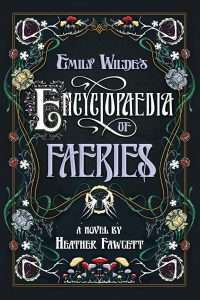 Emily Wilde’s Encyclopaedia of Faeries is written in the form of Emily’s diary–giving us very close insight into her mind. This also means the writing style isn’t going to click with everyone. It is rather dry, academic prose, recounting events in a matter-of-fact manner. I suspect Emily is written as Neurodivergent, though it is not made explicit in the text and this is pure speculation on my part as a (fellow) ND individual. For me, the writing was a large part of the charm. It’s not a story that the reader is told as much as field notes of a researcher, not intended for readers–it has something clandestine about it to read, which makes for a fun experience. The story is also full of scholarly footnotes, adding anthropological and historical information for the reader. I loved this, as I do all novels with footnotes–but I know this won’t be for everyone. I do recommend picking up a sample of Emily Wilde’s Encyclopaedia of Faeries first if you’re intrigued but torn about narration.
Emily Wilde’s Encyclopaedia of Faeries is written in the form of Emily’s diary–giving us very close insight into her mind. This also means the writing style isn’t going to click with everyone. It is rather dry, academic prose, recounting events in a matter-of-fact manner. I suspect Emily is written as Neurodivergent, though it is not made explicit in the text and this is pure speculation on my part as a (fellow) ND individual. For me, the writing was a large part of the charm. It’s not a story that the reader is told as much as field notes of a researcher, not intended for readers–it has something clandestine about it to read, which makes for a fun experience. The story is also full of scholarly footnotes, adding anthropological and historical information for the reader. I loved this, as I do all novels with footnotes–but I know this won’t be for everyone. I do recommend picking up a sample of Emily Wilde’s Encyclopaedia of Faeries first if you’re intrigued but torn about narration.
Emily is not the easiest character to like–because of the writing style, characters don’t seem as plastic as they may be and she is thorny and introverted. To me, certainly, she had a lot of charm and the more I read, the more I felt with her and her struggles. I did find that the romance in the story wasn’t as built up as I would like, but again, I think that is a conscious choice on the part of the narration through a research diary rather than a flaw of the writing per se. Emily Wilde’s Encyclopaedia of Faeries is the sort of stories that will get a marmite reaction out of readers–either it works well for you, or it doesn’t work at all.
The themes of belonging and social pressure make this a timely read, and my reading of Emily herself as neurodivergent made Emily Wilde’s Encyclopaedia of Faeries stand out to me. A very interesting debut, and I look forward to seeing where the story goes and how Heather Fawcett develops as a writer!
Read Emily Wilde’s Encyclopaedia of Faeries by Heather FawcettThe post REVIEW: Emily Wilde’s Encyclopaedia of Faeries by Heather Fawcett appeared first on Grimdark Magazine.
February 19, 2023
An Interview with David Dalglish
David Dalglish is a highly prolific author, with over fifteen self-published and twelve traditionally published epic fantasy novels to his name. Dalglish’s fantasy series include The Half-Orcs (self-published), Shadowdance (Orbit Books), The Paladins (self-published), The Breaking World (47North), The Seraphim Trilogy (Orbit Books), and The Keepers (Orbit Books). His latest series is The Vagrant Gods, also published by Orbit. The first book of the series, The Bladed Faith, was released in 2022, and the next entry, The Sapphire Altar, drops on January 10, 2023.
 [GdM] Your upcoming novel, The Sapphire Altar, is the second entry in your new series, The Vagrant Gods. Could you tell us more about The Vagrant Gods? What excites you most about this latest series and where we are in the story?
[GdM] Your upcoming novel, The Sapphire Altar, is the second entry in your new series, The Vagrant Gods. Could you tell us more about The Vagrant Gods? What excites you most about this latest series and where we are in the story?
[DD] The Vagrant Gods, at its core, is about a group of found family rebels fighting against the overwhelming force of the Everlorn Empire. The prince of a conquered island, Cyrus, watches his parents slaughtered, his kingdom broken, and the two gods he’s been taught to worship killed before his eyes. Believed dead, he’s instead smuggled to the Ahlai family, who travel realm to realm, funneling wealth, arms, and training in to foster rebellions against the Everlorn Empire. Their hope is to turn Cyrus into a folklore hero, a sort of Robin Hood if you will, for the people to rally around. And so Cyrus becomes the Vagrant in disguise, and trains with the Ahlai family to become a killer capable of defeating an army known for killing gods.
With The Sapphire Altar, we’ve reached the folk hero stage. The Vagrant’s legacy has begun, and he’s had some epic fights to lend credibility to his claims. But the task before him is immense, and the bloody burdens of being the Vagrant are starting to wear on him, especially the idea of where Cyrus ends and the Vagrant begins. Worse, many who love him are starting to doubt victory is possible, and have begun searching for other solutions…including turning to foreign gods, or bringing back slain gods in forms far more vicious and cruel.
[GdM] How did you conceive the protagonist of The Vagrant Gods, Cyrus?
[DD] Funnily enough, he wasn’t the main protagonist originally. Much of the Vagrant Gods was salvaged from an initial rejected pitch titled Garden of the Bone Gods. One of the characters, the Vagrant, was originally introduced “fully formed” in a sense, to what Cyrus will eventually become in the Vagrant Gods. He was a mysterious assassin with an unknown past, and over time, you’d learn of how he was a prince of the conquered nation in disguise, seeking to avenge his slaughtered family and gods. So after the pitch was rejected, I went through Garden and yanked out a lot of the minor characters that I loved and reworked their backstories to fit them into this new idea. With Cyrus, I realized he could be the focal point, and instead of starting much later after the invasion, the book could follow his entire journey, now with a much greater emphasis on his personal revenge.
[GdM] In The Vagrant Gods, Cyrus is helped and propelled forward by supporting characters that are in depth and rounded as he is. Anyone of them could move forward have their own series easily. For example, the characters Stasia and Mari are complicated, flawed and compelling. What was their creation like? Did their characters evolve through the writing process, or did you have a solid idea of who they were from the start?
[DD] With this new trilogy I did something I’d never done before. While the story was still just bouncing around in my head, I focused pretty heavily on who the main cast would be, as well as what signature moment I’d include to introduce them. I fell in love with Stasia and Mari in particular, so much so that while I was still writing the third Keepers book, Voidbreaker, I took a few days off to write one chapter for each character, because I was determined not to lose that feeling of who they were. With Mari Ahlai, it was the introduction of her as a god-whisperer, a person who can commune with dead gods and petition them for their power. For Stasia, I had a single scene in my head, that of her pounding her ax into the bloody corpse of an imperial soldier, and it is in that mad, almost feral state, she is found by her stunned lover. When I came back to VG months later, I started with those scenes and began fleshing out the story around them, and getting a real feel for who they were. Stasia would be brash, crude, and immensely cocky. Mari would be a sweetheart, empathetic, and loathe battle…but still accept the responsibility of her role as a god-whisperer, and tear into battle just as fearsome as her older sister.
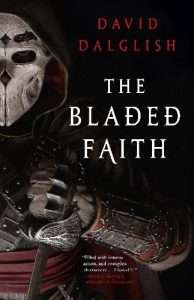 [GdM] You take on some very heavy themes in this story, especially the idea of colonialism and imperialism. Did you do any research into the effects of this kind of conquering, and the systematic destruction of culture and religion in preparation for writing this series?
[GdM] You take on some very heavy themes in this story, especially the idea of colonialism and imperialism. Did you do any research into the effects of this kind of conquering, and the systematic destruction of culture and religion in preparation for writing this series?
[DD] I looked at it from two angles. For the Everlorn Empire, well, I grew up in a very conservative, religious area, with a lot of people (due to literature like the Left Behind series) convinced the end times are approaching and a religious war will soon be fought across the Earth. Death will be everywhere, and there’s a chilling excitement toward this believed eventuality of millions upon millions of people all across the globe dying in horrific ways to plagues, curses, and the like. It’s not hard to take those sermons, that ideology, and rework it on an extravagant, fantasy scale. There is the God-Incarnate, and there are the heathen gods to be slaughtered and their people saved. There is a war to be fought, and it will be fought with prayer and blood sacrifice. I touched on this a little bit in Bladed Faith, but there’s a lot more of it in Sapphire Altar, especially through the POV of a former imperial paragon-turned-heretic, Arn Bastell.
As for the methods of the conquest, that I did research, as well as have some lengthy chats on the phone with multiple sensitivity readers. Almost everything in the book is a near one to one example of something previously done by, say, the British Empire in India or the US government to Native Americans. Honestly, a lot of what is in VG is toned down compared to some of the truly horrifying examples out there.
[GdM] I would love to know more about Cyrus’s religion, it is so creative. What was its inception? It is very different then the religious pantheons presented in today’s fantasy novels.
[DD] All of my novels have divine beings involved in some way. The Half-Orcs, for example, had jealous brother gods warring against each other, with humanity effectively serving as playing pieces on a board in their game to prove whose methods were superior in creating a lasting society. With VG, I wanted make these gods actively present in the day to day lives of those who worshiped them. And so it became more of a mutual trust, like children with a parent, for most of these gods…and at the same time, the beliefs of the people directly empower their gods, which means the gods are as much a reflection of the societies birthing them as they are shapers of those societies. Endarius the Winged Lion exemplifies strength, and gives that strength to those who love him. He attends feasts given in his name, and breathes upon the blind to restore their sight. He loves, and is loved, and is considered protector of his island, and effectively rules alongside the royal family he himself appointed.
And then comes the Everlorn Empire, who see these gods not as parents or guides but ruling monsters. Belief is literal power in VG, and if that belief is not given to the God-Incarnate, then it is dangerous, and must be captured at all costs.
[GdM] Your fight scenes are brutal. Many authors use different techniques when creating realistic and enthralling action sequences. How do you craft a believable fight scene? Do you storyboard, play it in your head, pants it, or another technique?
[DD] A good fight scene has an emotional flow to it, and I am extremely focused on that aspect above all else. A lot of the nitty gritty details are in service to what emotion I want to convey. Things going well? The hero is nimbly parrying every thrust, slashing and carving through his enemies with a grim smile. Am I trying to really push how horrible battles can be? Then we’re seeing the broken bones, we’re hearing the gasps and pained cries as swords slash open flesh and the dying crawl along the floor. Am I trying to keep things tense in a character specific duel? That’s when the heavy details come out. I’m describing the individual movements of every weapon, laying out their positions, what the POV character is hoping to do, what they see, the tells from a twist of an ankle or the pulling back of a parrying dagger. Details become clearer. The sound of steel hitting steel, the strain to hold back a brutal hit, the pain, the wrenching of muscles, all to slow down time and force you to stay in that moment as the battle commences until I’m ready to guide the emotional flow into the next release, be it victory or heartbreaking defeat.
[GdM] You have extensive experience as both a self-published and traditionally published author. What do you see as some of the pros and cons of these alternative routes to publication?
[DD] The best part of self-publishing is that you’re going it alone, unlike trade publishing, where you work with a team.
The worst part of self-publishing is that you’re going it alone, unlike trade publishing, where you work with a team.
If you are willing to be a marketer, a cover designer, to study trends, to set up Facebook ads, do book promos, do the formatting, and all the while also write the bloody book in the first place? Self-publishing can be amazing. It can also burn you out, and have you scrambling to wear a lot of different hats, some of which may simply not suit you no matter how hard you try.
[GdM] Over the course of your career, how have you seen indie publishing evolve? Do you see self-publication primarily as a pathway toward getting a traditional book deal, or do you think authors can establish and sustain a sizeable audience through self-publishing alone?
[DD] Well, when I first started, self-publishing was seen as something you did when you gave up ever having a trade deal. That, obviously, has now changed. But absolutely you can build a sizeable, sustainable income through self-publishing. People were doing that back when I started in 2010. There’s a staggering amount of money going to indies, but because of that, the market is absolutely ruthless now, infinitely more difficult and cutthroat than when I started. I consider myself beyond fortunate I started when I did. If I tried to launch an indie career now, I honestly do not know I’d have achieved even a fraction of the success I’ve had.
[GdM] You earned a degree in mathematics from Missouri Southern State University. How have you balanced your love of math with your passion for writing? What advice do you have for students who wish to pursue a dual career in English and a STEM field such as mathematics?
[DD] Hahahahaha there is no balance, no jobs, I spent like five years working for Pizza Hut after graduating with that degree and escaped only because my writing took off. My advice would be to do ANYTHING ELSE.
[GdM] How did you initially fall in love with fantasy? When were you first inspired to become a writer?
[DD] I grew up in a small town with a small library with an even smaller fantasy section, so while growing up, I didn’t read too much fantasy. I had the Lord of the Rings, the Hobbit, and a stack of comic books. What I did have, though, were games like Chrono Trigger, Final Fantasy VI, and Legend of Zelda. I adored their medieval aesthetics, and then one Christmas my parents bought a word processor. So began The Crystals of Power, my 60 page shameless FFIV rip-off, followed by a handwritten Chrono Trigger fanfic called Second Death. I had a folder I kept in my room full of story synopses, all planned to take place in a shared world. So I was already writing fantasy, and then a friend of mine loaned me the Dark Elf Trilogy by R. A. Salvatore. I read it once a year, every year, throughout high school. If I know how to write a fight scene, it’s because of Drizzt. From there, I grabbed whatever D&D novels I could find. To cap that off, my senior year, I had a Creative Writing class where the teacher just booked the computer lab, brought us there five days a week, and gave us the singular instruction of ‘write something’. Anything. Have a project, work on it, and she’d grade it depending on what it was (be it poems, short stories, or in my case, a 20k word novella). A lot of the early Half-Orcs world-building I did in that class, including the creation of multiple characters like the Paladin, Lathaar, or the Daughter of Balance, Mira.
[GdM] Could you tell us about your approach to writing? Do you develop a detailed outline before diving into the writing itself?
[DD] Everything starts with me daydreaming while I go on walks listening to music. I usually start very wide in terms of scope, pondering world-building aspects I think will allow me to do a lot of neat stuff. For Soulkeeper, as an example, I wanted a world where magic and monsters all appeared in a singular instant. Spells and healing prayers and fantastical creatures, going from stories and rumors to very real in the blink of an eye. From there, I brainstorm basic questions and answers. What creatures appear? What magic? How does it work now? Why is it appearing now? Who are the gods, and how are they involved now? When I start to lock down those big picture things, I then start pondering characters. First would be how they are involved in the grander picture (in Soulkeeper, I made the main POV hero someone who would be responsible for defending humanity from the sudden arrival of the unknown).
All of this I do in my head, and generally while I’m busy writing a different book. Things change drastically over the course of a few months as I toss ideas I don’t like and wonder how different things might work. A cast of three or four main characters bubbles up, and eventually, when it comes time to write, I have enough of a picture that I can write out a few initial chapters, establishing a narrative flow, some of the stakes, and the overall vibe of the story. After that? That’s when I start writing out an extensive outline, building on the things I’ve already decided and the goals I want to accomplish and try to figure out how to accomplish it all.
[GdM] You are under 40 years old and have already published over twenty-seven novels. What is your advice for achieving such a high level of productivity?
[DD] Ok so start really young, like, in your early twenties. Then get to be a professional writer as your full-time career from the age of twenty-six. Finally, crank out two books or so a year for twelve years straight, and you’ll hit that number. It’s just that easy.
I’m only being mildly sarcastic, honestly. I’ve been stupidly blessed with how my career path has worked, first through self-publishing, then traditional publishing with Orbit. I can hit this level of productivity because writing is my day job, and I try to do around 3k or so words a day, five days a week. Sometimes I hit it, plenty of times I don’t, but just the sheer amount of time dedicated to putting my butt in a chair and writing means twice a year, on average, I’ll have myself a finished novel that is hopefully something someone will want to read.
[GdM] You have created highly complex fantasy worlds. How do you keep everything straight and make sure there are no inconsistencies in your worldbuilding?
[DD] Well, first you launch your career writing nearly twenty novels set in the exact same world where you absolutely screw up and have inconsistencies in your world-building and even forget you killed off a character at one point…and THEN you start keeping an actual notebook like a smart person, full of character descriptions, family trees, timelines, and other things that can be hard to remember or impossible to find when you actually need it. For the Keepers Trilogy, for example, I have this tiny leather notebook just full of scribbles, lists showing what magical creature was created by which dragon, what the power structure for the Keeping Church is, etc. All things I desperately wish I had for the Half-Orcs, as I come back to it after several years to try to write its ninth book…
[GdM] Do you have a favorite book or series among your published works, or one that you feel especially proud of?
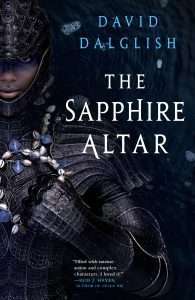 [DD] I think, without question, The Sapphire Altar is the best book I’ve even written. In terms of favorite, I still cherish the fourth Paladins novel, The Broken Pieces, just because the final few chapters are about the most emotionally impactful writing I’ve ever done and years later I still get the occasional email from readers heartbroken and devastated and wanting to either thank me or yell angrily at me. Or both.
[DD] I think, without question, The Sapphire Altar is the best book I’ve even written. In terms of favorite, I still cherish the fourth Paladins novel, The Broken Pieces, just because the final few chapters are about the most emotionally impactful writing I’ve ever done and years later I still get the occasional email from readers heartbroken and devastated and wanting to either thank me or yell angrily at me. Or both.
[GdM] Your series, The Breaking World, is coauthored with Robert J. Duperre. What is the experience like working together with a coauthor vs writing solo?
[DD] Rob deserves so much credit for that whole trilogy. It wasn’t a true co-authorship like some friends I know, in which each of us wrote equal amounts in the original draft. With Breaking World, I kinda let Rob go nuts in my own world. He’d been with me from the very beginning of my career, and was who I went to with phone calls whenever I got stuck on a story idea. So he wrote the vast majority of the rough draft. After every chapter, I’d immediately tear into it that day or the next, rewriting portions, melding the voice to something more of a mixture of mine, and overall making sure it matched my earlier books in Dezrel. And then we’d have more phone calls, arguments about the fates of various characters, or sometimes I’d just ax an entire chapter because I hated where it was going. I was an awful tyrant, sometimes. How he’s still my friend, I don’t know.
[GdM] What are some of your biggest inspirations? Any influences that would surprise your readers?
[DD] Plenty of them people can guess, I’d say. Trigun massively influenced how I write heroes. JRPGs in general have me creating little found family groups for almost every novel of mine. You can hear the rolling of dice from D&D in the Half-Orcs and the Keepers Trilogy. Probably the most random influence would be a phase I went through in college where I read nearly every single Stephen King novel and short story collection I could find. I’d say it, combined with R.A. Salvatore’s influence, have made my writing pretty accessible.
[GdM] Which book or series do you recommend as the best entry point for readers new to David Dalglish?
[DD] This has actually become a difficult question to answer because what I tried to do with each major series varies over the course of these last twelve years. In the end, I usually try to guide people to the type of fantasy they like. If you want assassins and breakneck pacing in a relatively low fantasy setting, start with A Dance of Cloaks. Are magical creatures, unique world-building, and kind-hearted heroes your thing? Soulkeeper. Just want the best written book, with the strongest, most diverse cast of characters? The Bladed Faith.
That said, each series of mine is meant to stand alone, so you can also dive into The Half-Orcs or The Paladins, but I’m always a little hesitant to lead people to those first since they’re some of my oldest writing and, well, it can be a little rough and weird over there.
[GdM] What are your upcoming plans after finishing The Vagrant Gods series?
[DD] Well, as I mentioned earlier, I’m usually plotting out the basics of the next story while finishing out the old, and I did the same with book three of Vagrant Gods. Not only am I about halfway done with the rough draft of the ninth Half-Orc novel, Legacy of the Watcher, but I’ve got about four chapters done on a pitch for a brand new world, one that hews a bit closer to the mysterious world building of Soulkeeper, but with a more low fantasy setting and overall darker vibe. We’ll see if it goes anywhere!
David Dalglish graduated from Missouri Southern State University in 2006 with a degree in Mathematics. He’s self-published over fifteen novels, as well as had twelve books traditionally published through Orbit Books and 47North.
He also has a lovely wife and three beautiful daughters, with all four being far better than he deserves.
Interview Conducted by John Mauro and Beth Tabler
Check Out “The Vagrant Gods” by David DalglishThe post An Interview with David Dalglish appeared first on Grimdark Magazine.
February 18, 2023
REVIEW: Ordinary Monsters by J.M. Miro
Ordinary Monsters is a gas-lit fantasy romp primarily set in Victorian England and Scotland, but with side-stops in America and Japan. While the larger setting is not overwhelmingly fantastical – the Victorian elements largely accord with our historical version – the story revolves around those fantastical elements that differentiate this world from ours.
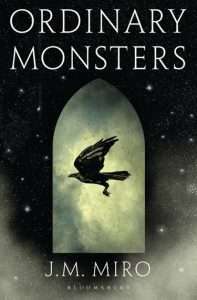 Ordinary Monsters utilises the popular trope of a secret society of magic users (although I use the term magic loosely here) operating outside the mundane everyday world. Given the time period, this allows ample opportunity to lean heavily on Victorian archetypes of occult spiritualism, moneyed clubs with hidden agendas and, yes, orphans.
Ordinary Monsters utilises the popular trope of a secret society of magic users (although I use the term magic loosely here) operating outside the mundane everyday world. Given the time period, this allows ample opportunity to lean heavily on Victorian archetypes of occult spiritualism, moneyed clubs with hidden agendas and, yes, orphans.
The secret society in question operates the mysterious Cairndale Institute, which recruits chosen children to board on its grounds in Scotland. Admission requires certain special “Talents”, which are the equivalent of innate superpowers. Invisibility and accelerated healing get a look in, along with some more novel powers, such as the ability to manipulate soot and dust. Recruitment, it should also be said, is an aggressive rather than a passive process. The Institute’s agents actively seek out disinherited children worldwide to install within their program.
Overseeing the Cairndale Institute is the enigmatic Dr Berghast, but his true intentions are murky to say the least. Is he a true philanthropist or is there a darker agenda involved?
The story initially follows private detective Alice Quicke, employed by the Institute to locate a young American talent named Charlie Ovid, who possesses powers of self-healing. Charlie is incarcerated in a Natchez City warehouse while the local judiciary and police try to figure out what to do with someone sentenced to death but who cannot be killed. After this case resolves, and not without some bloodshed, Alice leaves Charlie with her partner and goes it alone to find an eight-year-old potential recruit named Marlowe. However, soon after taking charge of him, Alice becomes aware that malignant forces are after the boy and they are both in grave danger.
As the children and Alice delve more deeply into the mysteries of the Institute and its enemies, so to do they delve deeper into the magical underworld that underpins this alternate Victorian era world. The Institute has quite the history it seems, and this history is tied to a disgraced former student named Jacob Marber. Along with Charlie and Alice, Marber is a viewpoint character and a central antagonist. As the novel progresses, flashbacks involving Jacob Marber allow the novel to venture away from Scotland to explore historical Japan, while also granting insight into the history of the Institute and the genesis of Marber’s conflict with the Institute.
The story entails plenty of action and super-powered battles, including a major set-piece on a steam train. Supernatural creatures, a portal to the land of the dead and magical artifacts all make an appearance as Alice, Charlie and the Institute children begin to unravel the Institute’s secrets.
So, did Ordinary Monsters meet my expectations? No, it didn’t, but this is not necessarily a bad thing.
Ordinary Monsters’ cover sets up a mysterious, spiritual ambience, displaying a crow flying across a stormy green background and viewed through an archway. Using the author’s initials rather than full name also felt like a tip of the hat to a certain ambiguity. In part because of this, I was expecting it to lean into Victorian literature a bit harder than it does: ornate prose, indulgent description, maybe an antiquated style. I also expected it to be a bit more of a diabolical puzzle-box, with some sleight of hand, illusion and magical misdirection. It’s a hefty tome after all, somewhere over the 600-page mark in the trade paperback U.K. edition.
As it turned out, Ordinary Monsters’ style and tone fit comfortably into contemporary spec fic. The plot boils down to a prevent the end-of-the-world adventure, and in certain respects it had a Hollywood feel. YA overtones are also present, especially when the focus is off Alice or Jacob and on the children of the Institute. This is by no means a bad thing, it’s just different from what I was expecting.
If I were put to swordpoint, I’d say it could perhaps have been shorter and the characters could occasionally have been more rounded. I also would have preferred it if the mythology were a little deeper, and at times I found myself wondering about the underpinnings of the arcane elements. But that said, did I enjoy it? Yes, I did. It’s an entertaining, straightforward read, and the historical elements are a strong point. The Victorian era is richly and vividly described. I felt like I was up to my proverbial boots in the nightsoil of Victorian England.
My final verdict is that Ordinary Monsters is definitely worth checking out if you’re keen for some darker Victorian-era fantasy.
Read Ordinary Monsters by J.M. MiroThe post REVIEW: Ordinary Monsters by J.M. Miro appeared first on Grimdark Magazine.

